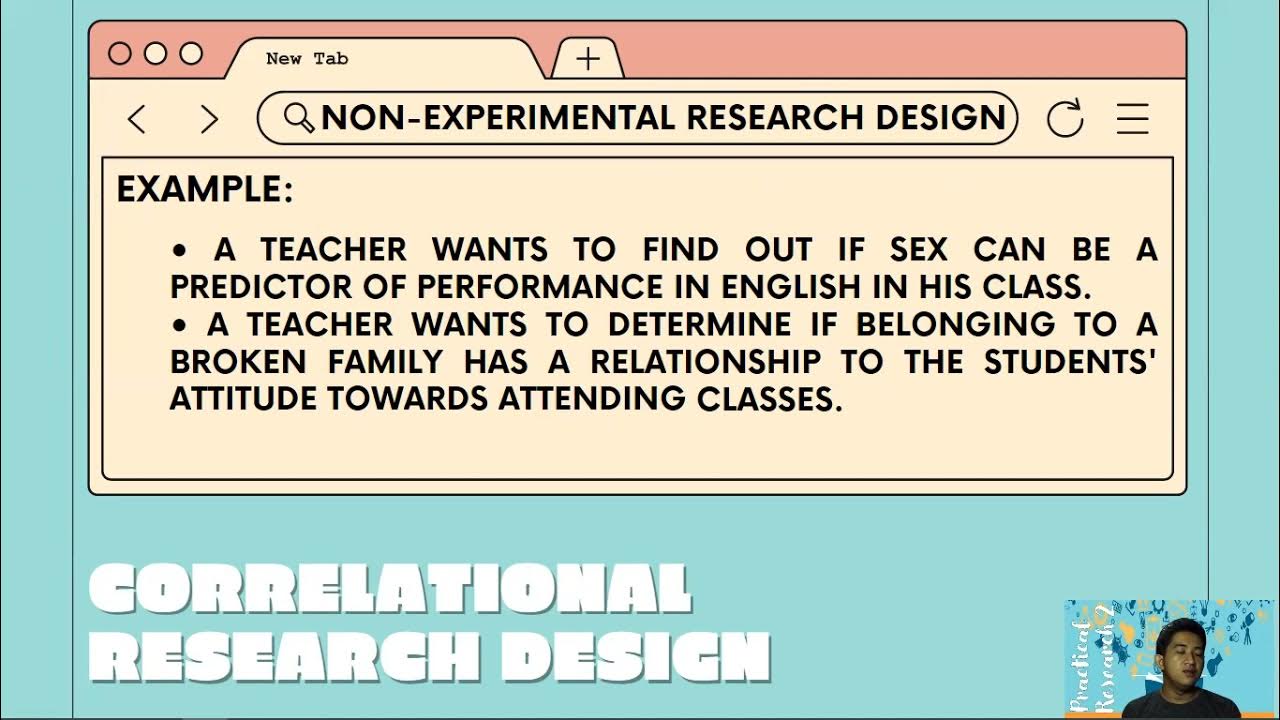Classification of Research design (3 types) Exploratory, Descriptive, casual research
Summary
TLDRThis educational video delves into the classification of research designs, crucial for structuring effective research projects. It outlines three main types: Exploratory, used for undefined problems with methods like focus groups and case studies; Descriptive, detailing phenomena with cross-sectional and longitudinal designs; and Causal, determining cause-effect relationships through experiments. Each type is exemplified with practical scenarios, providing a comprehensive guide for researchers.
Takeaways
- 📚 Research design is the framework of methods and techniques chosen by a researcher to ensure effective and efficient project execution.
- 🔍 Exploratory research is conducted to understand a poorly defined problem and identify potential areas for future research.
- 👥 Focused groups, case studies, and in-depth interviews are common methods used in exploratory research to gather insights from various perspectives.
- 📊 Descriptive research provides an in-depth description of a phenomenon or population, focusing on 'what' rather than 'why'.
- 📈 Cross-sectional and longitudinal designs are used in descriptive research to collect data at a single point in time or over a period, respectively.
- 🔗 Causal research aims to establish cause and effect relationships between variables, often used to identify the reasons behind certain behaviors or outcomes.
- 🧪 One-shot case studies, before-after studies with or without controlled groups are methods used to conduct causal research and evaluate the impact of interventions.
- 🏢 Business organizations, social sciences, and health sectors are examples of areas where case study research is widely applied to analyze existing cases and draw comparisons.
- 📈 Longitudinal studies track the same individuals over time to observe changes, which can span from weeks to decades, providing a deep understanding of long-term effects.
- 📝 The script provides practical examples from various sectors, such as the juice bar owner's exploratory research and the cereal brand owner's causal research, to illustrate the application of different research designs.
Q & A
What is the definition of research design?
-Research design is the framework of research methods and techniques chosen by a researcher, which lays the foundation for carrying out the project and ensures that the research is conducted effectively and efficiently.
What is exploratory research and why is it conducted?
-Exploratory research is conducted to investigate a problem that is not clearly defined. It is used to gain a better understanding of the existing problem and identify issues that may be the focus of future research, typically when the problem is in a preliminary stage.
What are the three methods through which exploratory research can be conducted?
-Exploratory research can be conducted through focused groups, case studies, and in-depth interviews.
How does a focused group method assist in exploratory research?
-A focused group method allows a group of people with common backgrounds and experiences to express their ideas on the subject under study, helping researchers understand consumer opinions and attitudes.
What is the purpose of a case study method in research?
-The case study method helps researchers analyze existing cases that have experienced a similar problem, allowing for a detailed understanding of variables and their impact on the current research.
How does an in-depth interview contribute to exploratory research?
-In-depth interviews, conducted in person or by phone with open-ended questions, provide detailed and valuable information from subject matter experts that may not be available from public sources.
What is descriptive research and what does it focus on?
-Descriptive research provides an in-depth description of the phenomenon or population under study, focusing more on the 'what' of the research subject rather than the 'why'.
What are the two ways to conduct descriptive research mentioned in the script?
-Descriptive research can be conducted through cross-sectional design, where data is collected from different people at one time, and longitudinal design, where the same individuals are examined over a period of time.
How does a cross-sectional study differ from a longitudinal study?
-A cross-sectional study collects data from a group of participants with varied characteristics at one time, while a longitudinal study examines the same individuals for changes over an extended period, which can range from weeks to decades.
What is causal research and what is its primary purpose?
-Causal research is a method used to determine the cause and effect relationship between two variables, primarily used to identify the cause of a given behavior by observing variations in an independent variable with changes in the dependent variable.
What are the three types of causal research designs discussed in the script?
-The three types of causal research designs are one-shot case study, before-after with controlled group, and before-after without controlled group.
How does a one-shot case study differ from a before-after study with and without a controlled group?
-A one-shot case study observes a single group on a single occasion after an event, while a before-after study with a controlled group measures outcomes in both a treatment group and a control group before and after treatment, and a before-after study without a controlled group only measures the dependent variable in a single group before and after treatment.
Outlines

此内容仅限付费用户访问。 请升级后访问。
立即升级Mindmap

此内容仅限付费用户访问。 请升级后访问。
立即升级Keywords

此内容仅限付费用户访问。 请升级后访问。
立即升级Highlights

此内容仅限付费用户访问。 请升级后访问。
立即升级Transcripts

此内容仅限付费用户访问。 请升级后访问。
立即升级浏览更多相关视频

Quantitative Research Design

Develop a Theoretical Framework in 3 Steps | Scribbr 🎓

Jenis dan rancangan penelitian (Metode Penelitian)

TYPES OF QUANTITATIVE RESEARCH || PRACTICAL RESEARCH 2

Research Gap 101: What Is A Research Gap & How To Find One (With Examples)

QUALITATIVE Research Design: Everything You Need To Know (With Examples)
5.0 / 5 (0 votes)
